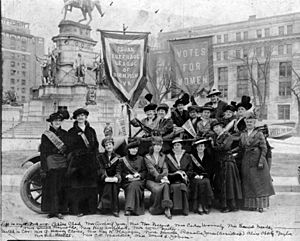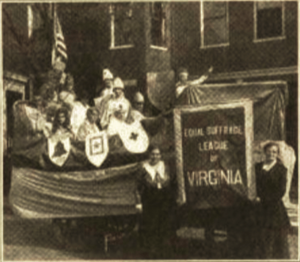Equal Suffrage League of Virginia facts for kids
The Equal Suffrage League of Virginia was a group started in 1909 in Richmond, Virginia. Its main goal was to help women get the right to vote. This was a big movement happening across the United States at the time.
In 1920, the 19th Amendment was added to the U.S. Constitution. This important amendment finally allowed women to vote in all states. After this, the Equal Suffrage League changed its name and became the Virginia League of Women Voters. This new group joined the national League of Women Voters. Even though the 19th Amendment passed in 1920, Virginia officially approved it much later, in 1952.
Some of the first leaders of the league included Lila Meade Valentine, who was the first president. Kate Waller Barrett was the vice president. Adele Goodman Clark worked as the secretary and helped the group talk to lawmakers in the Virginia General Assembly. Other important people who helped start the league were Nora Houston, Ellen Glasgow, and Mary Johnston.
Contents
History of the League
How It Started
The Equal Suffrage League of Virginia began with a series of meetings in November 1909. These meetings took place at the home of Anne Clay Crenshaw in Richmond. Her mother, Mary Jane Warfield Clay, was also a supporter of women's voting rights from Kentucky.
The first meeting on November 20 included "women interested in the formation of the Virginia Suffrage League." A week later, the group chose its leaders. The eighteen original founders included Lila Meade Valentine as president, Kate Waller Barrett as vice president, and Adele Goodman Clark as secretary. Other founders were Nora Houston, Ellen Glasgow, and Mary Johnston. In its first year, the league quickly grew to 120 members, mostly from Richmond. Many of these members were well-known women who used their connections and resources to help spread their ideas.
On January 21, 1910, the league held its first big public event. They invited Dr. Anna Howard Shaw, who was the president of the National American Woman Suffrage Association, to give a speech.
What They Faced
By 1909, the movement for women's voting rights was gaining strength across the country. However, in Virginia and other Southern states, the movement faced more challenges. Some people who were against women voting worried about how it might change society or affect who had power. Supporters of women's suffrage tried to explain that giving women the right to vote would not cause big problems.
How They Grew
The Equal Suffrage League of Virginia was connected to the National American Woman Suffrage Association. However, the Virginia group often felt like it was behind the national movement. While the national group was already talking to politicians, the Virginia league had to focus more on teaching people and raising awareness. This meant the state's efforts started a bit slower.
The league's early work included going door-to-door to talk to people, handing out flyers, and giving public speeches. Leaders traveled across the state, visiting women's colleges, schools, fairs, and union meetings. In Richmond, a group of businessmen even started their own Men’s Equal Suffrage League of Virginia to help. These efforts helped the movement grow quickly. By 1914, the league had 45 local groups across Virginia. This number grew to 115 by 1916. By 1919, ten years after it started, the league had an amazing 30,000 members! At this point, they worked hard to change the state constitution so women could vote.
Their Big Goal
The Equal Suffrage League of Virginia stopped operating shortly after the 19th Amendment passed in 1920. It then became the Virginia League of Women Voters. The new group's goal was to help women register to vote, teach them about important issues, and support social improvements. With the 19th Amendment, women in Virginia gained the right to vote. However, the Virginia General Assembly did not officially approve the amendment until 1952.
Notable Members
- Adele Goodman Clark
- Mary Johnston
- Lila Meade Valentine
- Elizabeth Langhorne Lewis
- Maud Jamison
- Grace Phillips Pollard
See also




